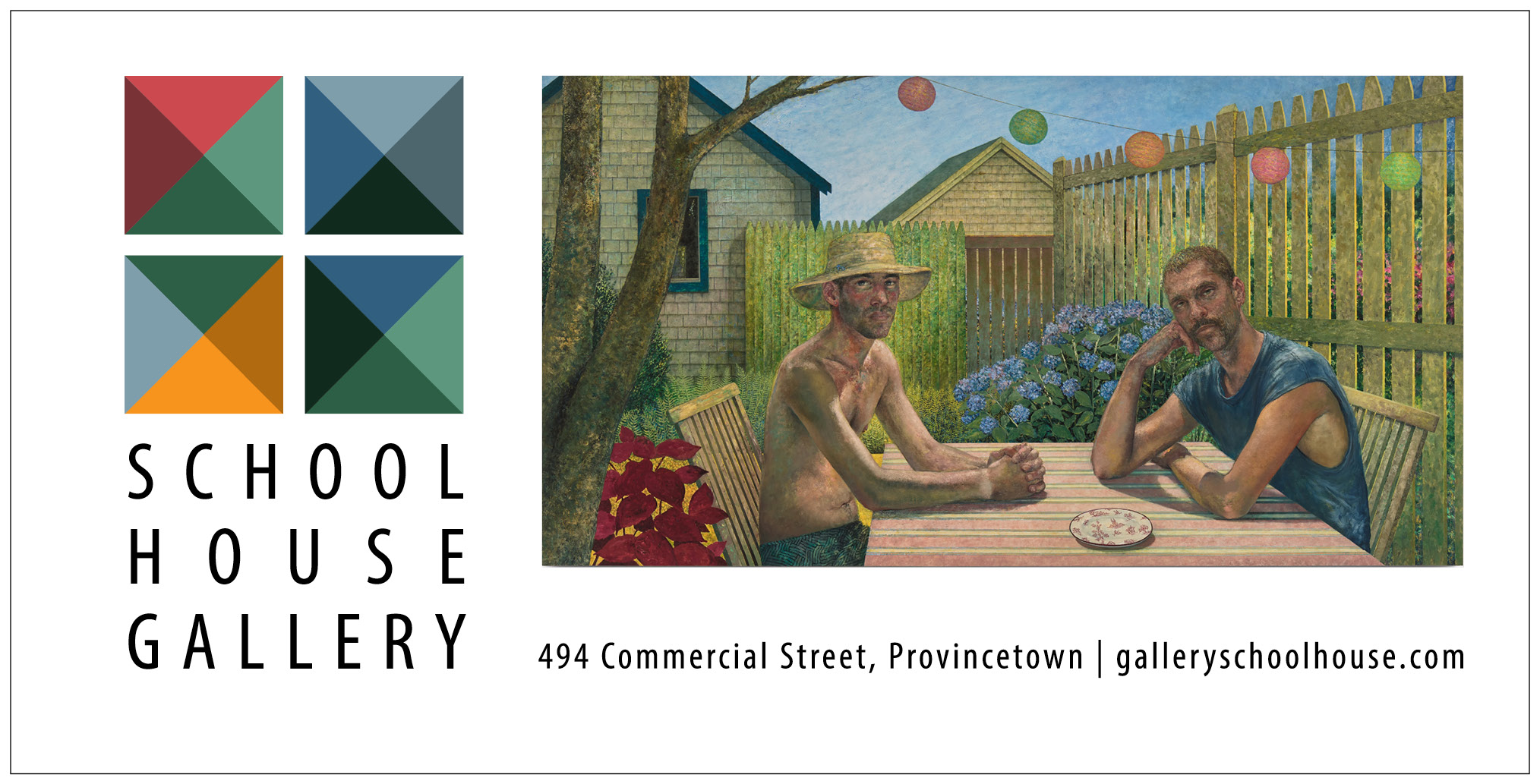AMZehnder Gallery (25 Bank St.)
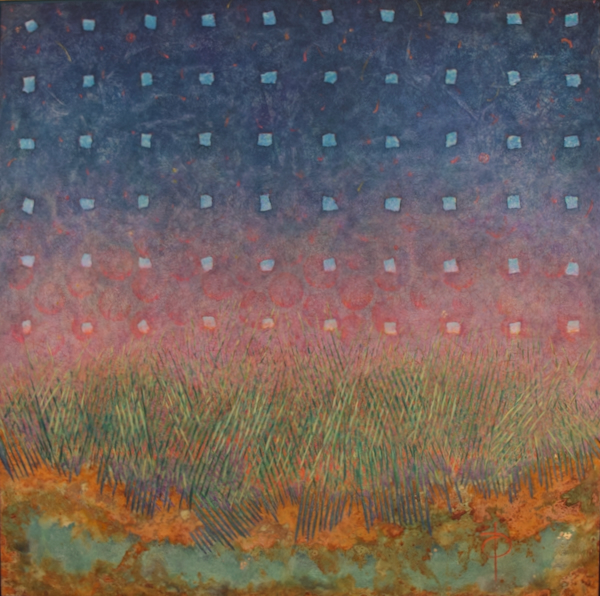
“I may be a little biased,” says Peter Ormsby, visiting from New York City. “My mom’s the artist.” When challenged to pick his favorite canvas by his mother, Patte Ormsby, he responds with only a hint of fear. “I think my mom might kill me,” he says, pointing to Night Over Day by the Side With the Bay.
“I’m a huge fan of color,” he says, looking at the large square painting made of spray enamel, oil, gold leaf, patina, and rust. “It very much brings out the Cape, with the reeds and the grass, but there’s also the geometry of the squares in the sky and the crisscrossing reeds.”
Patte Ormsby overhears her son’s pick. “Oh, really?” she retorts. “You have to be careful, or someone will put dibs on it.”
Blue Heron Gallery (20 Bank St.)
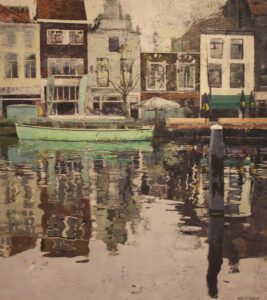
Amy Christian of Fairfield County, Connecticut thinks that encaustic paintings made using hot wax are “absolutely stunning.” She appreciates the time it takes to create them. “If it’s done the original way, it can take days or even weeks,” says Christian.
She points to her favorite piece in the room, Dale O. Roberts’s Amsterdam’s Cousin. “I just want to be there,” she says. Christian describes herself as a “water person,” and Roberts’s depiction of Amsterdam’s canals immediately captivated her. “He’s just incredibly gifted,” she says. “There are encaustics of all kinds, including a more modern type that takes shortcuts, but the way he does it is reminiscent of the original technique used by the Egyptians thousands of years ago.”
Burdick Art Gallery (25 Bank St.)
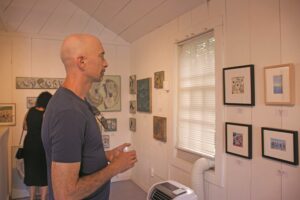
Josh Hassel is from Lexington. But, he explains with a smile — and a glass of prosecco in hand — “I’ve been spending summers here my whole life.” He works in technology research for the Dept. of Transportation, and his wife is an artist.
He likes Margaret Burdick’s watercolors, Raw Bar Relics in particular. Something in the canvas resonates with him.
“I’ve done shellfishing,” he says. The familiarity of Burdick’s whole series strikes a chord of nostalgia. “I have such a fondness for the Cape and for Wellfleet, and all of her work is Cape scenes,” says Hassel. “They feel familiar. Even if I haven’t been to this particular spot, I recognize it.”
Celeste Fine Arts Gallery (75 Commercial St.)
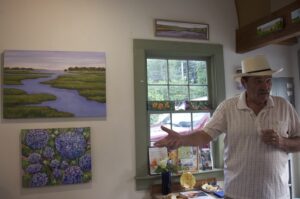
Zygmunt J. Koper is a proud Arizonian. “I’ve never been a fan of the East Coast,” he says. “There’s humidity, it’s watery, and things in the water bite you.” Because of his wife, Celeste Koper, the artist and curator behind Celeste Fine Arts Gallery, he spends summers in Wellfleet, where he works for Chatham Fish. Despite his preference for the desert, his favorite piece in the gallery is the swirling watery scene in Blackfish Creek, painted by his wife.
He says the painting beautifully captures the landscape of Wellfleet and that the rich colors bring it all together: “It almost jumps out and grabs you, doesn’t it?”
Despite being mesmerized by the painting, he says he’s looking forward to returning to his horses in Arizona come winter.
“I’m not going to lie,” says Koper. “If it wasn’t for her, I wouldn’t live here.”
Cove Gallery (15 Commercial St.)
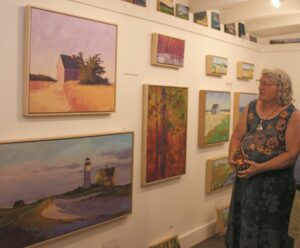
Kathy Morris, a retired psychologist from Wilmington, Del., can’t stop looking at the sweeping shadows of Mary Moquin’s paintings, particularly one of a shadowed house titled Windswept. Morris says that the artist’s attention to light and how well it evokes Cape Cod sets it apart.
Morris has been coming to the Cape every summer since she was 10 years old. She feels at home among Moquin’s paintings.
“It looks like what I see when I come to the Cape,” she says. “The Cape light is very beautiful and unusual.” Morris especially likes the light at the end of the day. “It brings up fond memories,” she says. “It’s nostalgic.”
Farm Projects (355 Main St.)
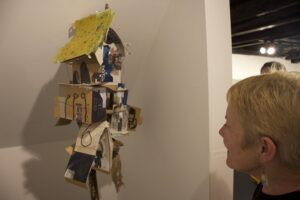
Wendy Luttrell says she feels that “something very magical was going on” when looking at Kelly Knight’s mixed-media sculptures. In addition to working as a sociology professor at the City University of New York, she co-curates the work at Off Main Gallery in Wellfleet with her husband, Robert Shreefter.
Luttrell says she loves all of Knight’s work but is particularly struck by one called To Say We Were Here, tucked into a corner of the room. “I loved turning and seeing what felt like a birdhouse community in that little nook,” she says, noting how the piece evokes nesting and home spaces. But she backtracks on assigning any labels to the art. “I’m not supposed to say that because then you will never be able to see it again without thinking of birdhouses.”
